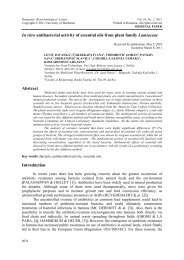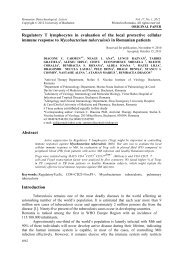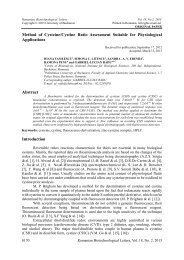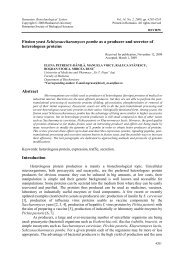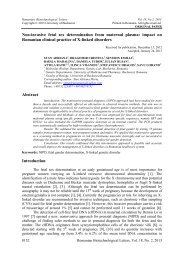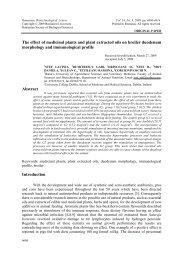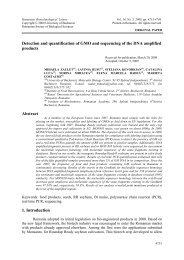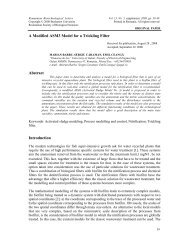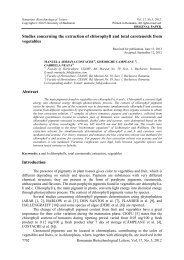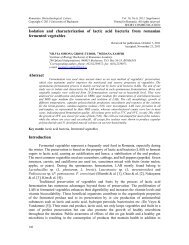In search of plant sources for serine protease inhibitors ... - Rombio.eu
In search of plant sources for serine protease inhibitors ... - Rombio.eu
In search of plant sources for serine protease inhibitors ... - Rombio.eu
Create successful ePaper yourself
Turn your PDF publications into a flip-book with our unique Google optimized e-Paper software.
Romanian Biotechnological Letters Vol. 15, No.5, 2010Copyright © 2010 University <strong>of</strong> BucharestPrinted in Romania. All rights reservedORIGINAL PAPER<strong>In</strong> <strong>search</strong> <strong>of</strong> <strong>plant</strong> <strong>sources</strong> <strong>for</strong> <strong>serine</strong> <strong>protease</strong> <strong>inhibitors</strong>: I. Detection <strong>of</strong><strong>serine</strong> <strong>protease</strong> <strong>inhibitors</strong> in callus cultures induced from somatic ex<strong>plant</strong>s<strong>of</strong> flax (Linum usitatissimum L.)Abstract5668Received <strong>for</strong> publication, May 15, 2010Accepted, September 24, 2010, ٭٭ , MARIA SPIRIDON ٭٭ MIHAELA-CARMEN EREMIA ,٭ROSU ANA٭JURCOANE , STEFANA ٭٭ IRINA LUPESCU ,٭GUIDEA SILVANARomania.E-mail: Center٭ <strong>of</strong> Microbial Biotechnology, 59, Bd. Marasti, 011464 Bucharest,anabiotech@yahoo.comNational٭٭ <strong>In</strong>stitute <strong>for</strong> Chemical Pharmac<strong>eu</strong>tical Re<strong>search</strong> and Development, 112 CaleaVitan, 031299, Bucharest, RomaniaA study was conducted in order to generate callus cultures in somatic ex<strong>plant</strong>s <strong>of</strong> flax (Linumusitatissimum L.) <strong>for</strong> their possible exploitation as <strong>sources</strong> <strong>for</strong> production <strong>of</strong> useful <strong>serine</strong> <strong>protease</strong><strong>inhibitors</strong>. The effect <strong>of</strong> <strong>plant</strong> growth regulators on callus induction in cotyledonary ex<strong>plant</strong>s andapical nodes prelevated from 10 days old flax seedlings was studied in order to produce rapidlygrowing callus biomass. The callus growth / culture vessel was recorded be<strong>for</strong>e the transfersper<strong>for</strong>med at 3 weeks intervals. The most efficient culture <strong>for</strong>mulation <strong>for</strong> callogenesis consisted inMS basal medium supplemented by NAA, TDZ and CH. The biochemical totipotency <strong>of</strong> the calluscells was evaluated by the presence <strong>of</strong> <strong>serine</strong>-<strong>protease</strong> <strong>inhibitors</strong> in callus biomass compared toseeds, assessed by analytical determinations <strong>of</strong> enzymatic dosing toward trypsine.Key words: auxins, cytokinins, in vitro cultures, callogenesis, trypsine, tryptase <strong>inhibitors</strong>.<strong>In</strong>troductionThe <strong>plant</strong> kingdom has a tremendous potential in natural product synthesis, itsbiosynthetic repertoire including compounds which can be harnessed <strong>for</strong> commercialapplications as dyes, pharmac<strong>eu</strong>ticals, fragrances, insecticides and other phytochemicals <strong>of</strong>practical interest. Among these compounds, <strong>plant</strong>- derived medicines constitute a substantialcomponent <strong>of</strong> present day human healthcare systems worldwide, because many irreplaceablemedicinal products are derived from <strong>plant</strong>s. Over 25% <strong>of</strong> the new drugs approved in the last30 years are based on a molecule <strong>of</strong> <strong>plant</strong> origin, and about 50% <strong>of</strong> the top selling chemicalsderive from knowledge on <strong>plant</strong> secondary metabolism (1, 2, 4,16). Less exploited up to noware some <strong>protease</strong> <strong>inhibitors</strong>, ubiquitously abundant not only in animals and microorganisms,but also in some <strong>plant</strong> species, with important uses in medicine and biotechnology.Proteases are proteolytic enzymes that catalyse the hydrolytic cleavage <strong>of</strong> specificpeptide bonds in target proteins, thus being indispensable to the maintenance and survival <strong>of</strong>their host organism. Proteases are mostly classified according to the main catalytic amino acidresidue in their active site in several groups, such as: <strong>serine</strong> <strong>protease</strong>s, cysteine <strong>protease</strong>s,aspartic <strong>protease</strong>s and metallo<strong>protease</strong>s, the latter having a metallic ion in their active site(5,12).The <strong>serine</strong> <strong>protease</strong>s are by far the largest class, comprising about 1/3 <strong>of</strong> the total<strong>protease</strong>s, being recognized as important factors in the control <strong>of</strong> multiple pathwaysassociated with coagulation, fibrinolysis, connective tissue turnover, homeostasis,fertilization, complement activation and inflammatory reactions. These enzymes are alsoinvolved in many diseases, there<strong>for</strong>e they are <strong>of</strong>ten targets <strong>for</strong> therap<strong>eu</strong>tic interventions (11).
<strong>In</strong> <strong>search</strong> <strong>of</strong> <strong>plant</strong> <strong>sources</strong> <strong>for</strong> <strong>serine</strong> <strong>protease</strong> <strong>inhibitors</strong>: I. Detection <strong>of</strong> <strong>serine</strong> <strong>protease</strong> <strong>inhibitors</strong> in calluscultures induced from somatic ex<strong>plant</strong>s <strong>of</strong> flax (Linum usitatissimum L.)Despite their key role in many biological processes, <strong>protease</strong>s may be potentiallydamaging when over-expressed or present in higher concentrations. The process is carefullycontrolled, <strong>for</strong> not being hazardous to the organism itself, by a large number <strong>of</strong> naturallyoccurring <strong>protease</strong> <strong>inhibitors</strong> described in animals, microorganisms and <strong>plant</strong>s(5).Plant PIs are generally small proteins that have mainly been described as occurring instorage tissues, such as tubers and seeds, but they have also been found in the aerial parts <strong>of</strong><strong>plant</strong>s, <strong>of</strong>ten induced in response to injury or attack by insects or pathogens (14).Among compounds able to selectively abrogate <strong>serine</strong> <strong>protease</strong> actions, the <strong>serine</strong><strong>protease</strong> <strong>inhibitors</strong> are able to <strong>for</strong>m less active or fully inactive complexes with their cognateenzymes and there<strong>for</strong>e they can be used either as drugs by themselves or may serve astemplates <strong>for</strong> the design and development <strong>of</strong> highly specific drugs (7). Consequently muchwork has been done to identify new <strong>sources</strong> <strong>for</strong> these compounds and to develop effectivemethods <strong>for</strong> purification <strong>of</strong> both proteolityc enzymes and their <strong>inhibitors</strong>.Among the serious diseases in which some <strong>serine</strong> <strong>protease</strong>s are involved, allergies,including asthma, have high clinical and economic impact. Β – Tryptase is a <strong>serine</strong> <strong>protease</strong>involved in the pathogenesis <strong>of</strong> asthma and in other allergic and inflammatory disorders thatare resistant to all known endogenous <strong>protease</strong> <strong>inhibitors</strong> (9). There<strong>for</strong>e much attention isfocused on the development <strong>of</strong> highly potent and selective tryptase <strong>inhibitors</strong>, including those<strong>of</strong> <strong>plant</strong> origin.<strong>In</strong> the range <strong>of</strong> <strong>plant</strong> species important as <strong>sources</strong> <strong>of</strong> tryptase <strong>inhibitors</strong>, the commonflax ( Linum usitatissimum) enjoy a special place, due to the well known effect <strong>of</strong> the flaxseeds to alleviate digestion disorders, stabilize blood sugar levels, improve health <strong>of</strong> the skinand inhibit the development <strong>of</strong> some <strong>for</strong>ms <strong>of</strong> cancer (3). Some <strong>of</strong> these benefic effects aredue to <strong>protease</strong> <strong>inhibitors</strong>. The first <strong>serine</strong> – proteinase type inhibitor isolated from seeds <strong>of</strong>the Linaceae family is known as a molecule consisting in 69 amino-acid residues and amolecular mass <strong>of</strong> 7655 Da, containing a single di-sulfidic link and two Cys residues (8).The present re<strong>search</strong>es aimed both to experiment the production <strong>of</strong> new <strong>sources</strong> <strong>of</strong><strong>serine</strong> <strong>protease</strong> <strong>inhibitors</strong>, consisting in callus cell biomass induced from somatic ex<strong>plant</strong>s <strong>of</strong>flax and to develop effective methods <strong>for</strong> purification <strong>of</strong> proteolityc enzymes and their<strong>inhibitors</strong>.Materials and methodsEx<strong>plant</strong> <strong>sources</strong>: experiments were carried out using as ex<strong>plant</strong>s <strong>sources</strong> 10 days old<strong>plant</strong>lets obtained by germinating flax seeds purchased from local market in laboratoryconditions, in a 2:1 mixture <strong>of</strong> compost and peat;Ex<strong>plant</strong> types: cotylledon fragments and cotyledon nodes with fully expandedcotylledons;Surface sterilization <strong>for</strong> callus culture establishment: 3 minutes soaked in 10% w/vcommercial bleach (Domestos), followed by 3 rinses (5 minutes each) in sterile distilledwater; the external sterilization, inoculations and the subsequent transfers were carried outunder aseptic conditions, in a laminar flow cabinet;Culture conditions <strong>for</strong> callus cultures induction and establishment : sterilized ex<strong>plant</strong>swere placed on the surface <strong>of</strong> the culture media (Variants 1 and 2) distributed in 5 cm ø Petriplates (containing 5 ml <strong>of</strong> sterile autoclaved culture medium variants solidified with 8 g/lagar) and the incubation was per<strong>for</strong>med in the growth chamber,at 25± 2 °C, under a 16/8 hphotoperiod, with a light intensity <strong>of</strong> 3000 lux. The periodical transfers on fresh culturemedia were per<strong>for</strong>med at 3 week intervals.Romanian Biotechnological Letters, Vol. 15, No. 5, 2010 5669
ANA ROSU, MIHAELA-CARMEN EREMIA, MARIA SPIRIDON, SILVANA GUIDEA,IRINA LUPESCU, STEFANA JURCOANECulture media: full-strength Murashige and Skoog (1962) basal medium (MS), withthe addition <strong>of</strong> 3% sucrose, 0.8% agar and with different concentrations and combinations <strong>of</strong><strong>plant</strong> growth regulators (PGRs) - Table 1; <strong>plant</strong> growth regulator supplements were addedprior to the media autoclaving, which was carried out <strong>for</strong> 20 min at 121° C and the pH wasadjusted to 5.8 – 6, prior to autoclaving.. The evaluation <strong>of</strong> the best media <strong>for</strong>mulations <strong>for</strong>callus biomass development was per<strong>for</strong>med by determining the average <strong>of</strong> fresh weightincrease <strong>of</strong> the cell biomass /culture vessel during the 3 week intervals between transfers oneach <strong>of</strong> the media variants (Table 2).Table 1. Variants <strong>of</strong> PGRs in culture medium <strong>for</strong> callus induction in somatic ex<strong>plant</strong>s <strong>of</strong> flax (Linumusitatissimum) and <strong>for</strong> transfersVariant Auxins – mg/lCytokinins – mg/l CHNAA 2,4-D Kin TDZ mg/l1 2 - 1 - -2 1 0.5 0.5 - -3 2 - 1 - 2004 1 0.5 0.5 - 2005 1 - - 0.5 200Legend: PGRs = Plant growth regulators; NAA = α –naphthalene-acetic acid; 2,4-D = 2,4-dichlorophenoxyacetic acid; Kin = Kinetin; TDZ = Thidiazuron (N-phenyl-N-1,2,3-thiadiazol-5-yl urea); CH =Casein enzymatic hydrolysateIsolation and purification <strong>of</strong> <strong>protease</strong> inhibitor.The extraction <strong>of</strong> <strong>plant</strong> proteins with <strong>serine</strong>-<strong>protease</strong> inhibiting activity from flaxcallus biomass compared to the flax seeds was conducted according to the followingprotocol:1 – defatting <strong>of</strong> the pulverized seeds and <strong>of</strong> the minced callus cell biomass by stirring<strong>for</strong> 2 hours at room temperature with 5 volumes (w/v) <strong>of</strong> acetone. The precipitate wasseparated by centrifugation and dried under vacuum;2 – the dry defatted powder is submitted to an aqueous extraction with an optimalvolume <strong>of</strong> 0.1 M acetate buffer, at pH 5.0, with stirring at 4° C, <strong>for</strong> 1h;3 – the resulted suspension was clarified by centrifugation at 4000rpm <strong>for</strong> 30 min, thepellet was discarded and the supernatant rich in proteins was separated;4 – the aqueous supernatant contains besides proteins some other compound, such aspolysaccharides, which were fractionally precipitated with ethanol in 2 stages: a) treatment <strong>of</strong>the supernatant with an equal volume <strong>of</strong> ethanol <strong>for</strong> 1 h at room temperature and removing theprecipitate by filtration; b) the clear supernatant is treated with 4 volumes <strong>of</strong> ethanol at lowtemperature (-20°C) and maintained in the refrigerator at 4° C <strong>for</strong> 24 hours;5- the crude protein precipitate was collected by centrifugation at 4000 rpm and driedunder vacuum and the resulted powder was dissolved in distilled water and clarified byfiltration;6 – in the case <strong>of</strong> flax seed extract, the protein solution containing <strong>serine</strong> <strong>protease</strong>inhibitor was brought to ph 7.5 with 2m Tris and applied to a column packed withimmobilized trypsin in chitosan gel by crosslinking glutaraldehyde and equilibrated with 0.05m Tris-HCl buffer, pH 7.5. The adsorbed inhibitor was eluted with 0.1M glycine HCl bufferpH 2.8.Measurement <strong>of</strong> enzyme inhibitory activity and protein assays. The kinetic <strong>of</strong> theenzymatic reactions was followed by using a rapid method based on BAPA ( N-benzoyl-DLarginin-4-nitroaniline),the inhibitory activity being determined as the difference between theactivity <strong>of</strong> a trypsin solution and the residual activity <strong>of</strong> the same solution after adding theinhibitor. The ability <strong>of</strong> various trypsin <strong>inhibitors</strong> (tryptase is <strong>serine</strong> <strong>protease</strong> like trypsin) to5670 Romanian Biotechnological Letters, Vol. 15, No. 5, 2010
<strong>In</strong> <strong>search</strong> <strong>of</strong> <strong>plant</strong> <strong>sources</strong> <strong>for</strong> <strong>serine</strong> <strong>protease</strong> <strong>inhibitors</strong>: I. Detection <strong>of</strong> <strong>serine</strong> <strong>protease</strong> <strong>inhibitors</strong> in calluscultures induced from somatic ex<strong>plant</strong>s <strong>of</strong> flax (Linum usitatissimum L.)prevent trypsin hydrolysis <strong>of</strong> BAPNA is measured spectrometrically (405 nm, Ɛ= 9.96 cm 2µmol -1 ) AT 25°C, with a UV-Vis spectrometer by time course measurement <strong>of</strong> ΔAbs. Onetrypsin unit hydrolyzes 1.0 µmole <strong>of</strong> BAPNA per minute at pH 7.8 and 25°C and one trypsininhibitor unit (TIU) will decrease the activity <strong>of</strong> 2 trypsin units by 50%.Protein concentration was determined by Lowry method.Results and discussionsThough the common flax ( Linum usitatissimum L.) enjoy a special place in the range<strong>of</strong> <strong>plant</strong> species important as <strong>sources</strong> <strong>of</strong> tryptase <strong>inhibitors</strong> and despite that it was proven thatbiotechnology based on cell and tissue cultures represents a reliable alternative method <strong>for</strong>producing a wide range <strong>of</strong> active compounds, the re<strong>search</strong>es focused up to now only onpurification and characterization <strong>of</strong> <strong>serine</strong> <strong>protease</strong> <strong>inhibitors</strong> from flax seeds (8, 11). Asregards the in vitro approaches, the ef<strong>for</strong>ts focused on regeneration strategies by applications<strong>of</strong> the techniques <strong>of</strong> somatic embryogenesis, protoplast isolation and fusion, obtaining <strong>of</strong>haploids, gene transfer and expression (10).There<strong>for</strong>e, to our knowledge, there are no data inthe scientific literature regarding developing and exploiting flax cell and tissue cultures asvaluable <strong>sources</strong> <strong>of</strong> <strong>serine</strong>-<strong>protease</strong> <strong>inhibitors</strong>.It is well known that where possible, <strong>plant</strong>lets obtained from seeds germinated inaseptic conditions represent an optimal source <strong>of</strong> ex<strong>plant</strong>s, with a pronounced callogenic andmorphogenetic capacity. Our attempts to efficiently surface sterilizing flax seeds withoutaffecting the germination, was not successful. Consequently, our source <strong>of</strong> ex<strong>plant</strong>s consisted<strong>of</strong> 10 days old <strong>plant</strong>lets, with fully expanded cotyledons, obtained by seed germination inlaboratory conditions (Fig. 1).Figure 1. Flax <strong>plant</strong>lets used as ex<strong>plant</strong>s <strong>sources</strong> <strong>for</strong> establishing callus cultures.After a mild surface sterilization, ex<strong>plant</strong>s consisting <strong>of</strong> cotyledon fragments and <strong>of</strong>the whole cotyledonary node were inoculated on 2 variants <strong>of</strong> culture media (Table 1). Twodifferent combinations <strong>of</strong> auxins and cytochinins (V1 and V2) were used in the first stage <strong>of</strong>callus initiation and <strong>for</strong> callus culture establishment. The beginning <strong>of</strong> callus developmentwas observed within 2 weeks after ex<strong>plant</strong>s inoculation on the inductive media. Under theinfluence <strong>of</strong> PGR supplements, starting from the cut-edges <strong>of</strong> the ex<strong>plant</strong>s, the callogenesisprogressed, covering the entire surface <strong>of</strong> the ex<strong>plant</strong>s after 4 weeks since inoculation. Thecalli developed on these variants were yellowish – green, partly friable, with a pronouncedRomanian Biotechnological Letters, Vol. 15, No. 5, 2010 5671
ANA ROSU, MIHAELA-CARMEN EREMIA, MARIA SPIRIDON, SILVANA GUIDEA,IRINA LUPESCU, STEFANA JURCOANEreveal the potential <strong>of</strong> somatic ex<strong>plant</strong>s <strong>of</strong> Linum usitatissimum to develop in vitro long-term,continuous callus cultures, under the effect <strong>of</strong> optimal hormone concentrations.The studies regarding the presence <strong>of</strong> <strong>serine</strong> <strong>protease</strong> <strong>inhibitors</strong> in callus biomasscompared to seeds revealed a specific activity expressed as UI/mg protein <strong>of</strong> 600 in seedextracts and <strong>of</strong> 2184 in callus biomass, following the purification <strong>of</strong> the biologic material byprecipitation with ethanol. The higher quantity <strong>of</strong> the protein precipitate /100 g defattedmaterial and with a better specific activity in the case <strong>of</strong> cell culture biomass compared to theseeds represents an important argument that flax cell and tissue cultures may represent areliable alternative method <strong>for</strong> producing active compounds with important uses in medicine.AcknowledgmentsReferencesRe<strong>search</strong>es were per<strong>for</strong>med in the frame <strong>of</strong> the Project INSERP–PC–Nr.62–075/ 2008.1. ALFERMAN, A., W., 1995. Natural product <strong>for</strong>mation by <strong>plant</strong> cell biotechnology. Plant Cell, Tissue andOrgan Culture, 43, 199 – 205;2. BALANDRIN, A. W., KLOCKE, J.A., 1988. Medicinal, aromatic and industrial materials from <strong>plant</strong>s. <strong>In</strong>:Biotechnology in Agriculture and Forestry, Medicinal and Aromatic Plants I, Ed. by Y.P.S. Bajaj, SpringerVerlag, Berlin, Heidelberg, 191 – 199;3. CHEN, J., WANG, L., THOMPSON, L. U., 2006. Flaxseed and its components reduce metastasis aftersurgical excision <strong>of</strong> solid human breast tumor in nude mice. Cancer Lett. 234 (2): 168 – 175;4. GOMEZ - GALERA, S., PELACHIO, A.M., 2007. The genetic manipulation <strong>of</strong> medicinal and aromatic<strong>plant</strong>s. Plant Cell Reports, 26, 1689 – 1715;5. HABIB, H., FAZILI, K. M., 20007. Plant <strong>protease</strong> <strong>inhibitors</strong>: a defense strategy in <strong>plant</strong>s. Biotechnologyand Molecular Biology Review 2(3), 68 -85;6. JAMEEL, S., REDDY, V. M., RHODES, W.G., McFADDEN, B.A., 1984. Gel electrophoretic pr<strong>of</strong>iles <strong>of</strong>proteinases in dark-germinated flax seeds. Plant Physiol., 76, 730 – 734;7. LEUNG, D., ABBENANTE, G., FAIRLIE, D.P., 2000. Protease <strong>inhibitors</strong>: current status and futureprospects. J. Med. Chem., 43 (3), 305 – 341;8. LORENC – KUBIS, I., KOWALSKA, J., POCHRON, B., ZUZLO, A., WILUSZ, T., 2001. Isolation andaminoacid sequence <strong>of</strong> a <strong>serine</strong> proteinase inhibitor from common flax (Linum usitatissimum) seeds.ChemBioChem., 2 (1), 45 -51;9. MARTIN, T. J., 2004. Highly active <strong>inhibitors</strong> against human mast-cell tryptase: A potential approach toattack asthma? <strong>In</strong>novations<strong>for</strong>um, 02 – 04 December;10. MILLAM, S., OBERT, B., PRETOVA, A., 2005. Plant cell and biotechnology studied in Linumusitatissimum – a review. Plant Cell, Tissue and Organ Culture, 82(1), 93 -103;11. POLANOWSKI, A., WILIMOWSKA - PELC, A., KOWALSKA, J., GRYBEL, J., ZELAZKO, M.,WILUSZ, T., 2003. Non – conventional affinity chromatography <strong>of</strong> <strong>serine</strong> proteinases and their <strong>inhibitors</strong>.Acta Biochimica Polonica, Vol. 50, No 3, 765 – 773;12. POUVREAU, L., 2004. Occurrence and physico – chemical properties <strong>of</strong> <strong>protease</strong> <strong>inhibitors</strong> from potatotuber (Solanum tuberosum). Ph. D. Thesis, Wageningen University, The Netherlands, ISBN: 90-8504-023-X, 2 – 30;13. RABINOVITCH – CHABLE, H., COOK – MOREAU, J., BRETON, J, C., RIGAUD, M., 1992.Purification <strong>of</strong> lipoxygenase and hydroperoxide dehydrase in flaxseeds: interactions between theseenzymatic activities. Biochemical and Biophysical Re<strong>search</strong> Communications, 188 (2), 858 – 864;14. RAI, S., AGGARWAL, K. K., BABU, C. R., 2008. Isolation <strong>of</strong> a <strong>serine</strong> Kunitz trypsin inhibitor from leaves<strong>of</strong> Terminalia arjuna. Current Science, 94 (11), 1509 – 1512;15. REIMER, J., 2008. Hematopoietic <strong>serine</strong> <strong>protease</strong>s from the mast cell chimase and tryptase loci – afunctional and evolutionary analysis. Acta Universitatis Upsaliensis, Upsalla, Sweden, 11 – 47;16. ROSU, A., 2004. Compusi fitochimici industriali: abordari Biotehnologice. <strong>In</strong>: Tratat de Biotehnologie,Vol.1, Ed. by S. Jurcoane, Editura Tehnica, Bucuresti, 631- 666.5674 Romanian Biotechnological Letters, Vol. 15, No. 5, 2010



